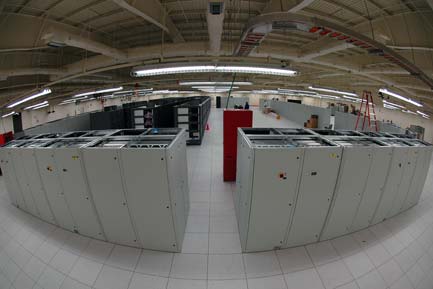Researchers virtualize supercomputer

A collaboration between researchers at Northwestern University, Sandia National Labs and the University of New Mexico is helping to democratize supercomputers by removing them from the confinement of their specialized operating systems.
The largest-scale study ever involving the virtualization of parallel supercomputing systems has led to the successful virtualization of Sandia's Red Storm supercomputer— the 17th fastest in the world — using an OS-independent virtual machine monitor called Palacios.
The team 'socialized' 4,096 of Red Storm’s total 12,960 computer nodes into accepting a virtual external operating system — a leap of at least two orders of magnitude over previous such efforts.
Peter A. Dinda, associate professor of electrical engineering and computer science at Northwestern's McCormick School of Engineering and Applied Science, and his graduate student Jack Lange led the development of Palacios while Sandia researchers, led by Kevin Pedretti, assisted in adapting and optimizing it for the Red Storm environment. The Sandia team also directed the testing effort.
“Our observation is that no single operating system will satisfy the needs of all potential users,” said Pedretti, “so we are attempting to leverage the virtualization hardware in modern processors to allow users to select the operating system best for them to use at run-time.”
The team leveraged virtualization hardware in modern processors with the goal of allowing users to select the operating system best for them to use at run-time. That meant enabling one machine to simultaneously run multiple operating systems, with the possibility of migrating these systems from one computer to another.
According to Sandia, to achieve this trick on Red Storm, a receptor operating system called Kitten was developed to work with Palacios. Operating through the filter of this programming translation, a program not native to Red Storm can run on nodes of the machine.
The researchers report that the Palacios virtual machine monitor had a measured overhead only 5 percent greater than compared to running Red Storm’s native, fixed programming. (Overhead represents the additional expense in time and efficiency of running the program in a virtualized environment).
“We believe the results show that the benefits of virtualization can be brought to even the largest computers in the world without performance compromises,” said Pedretti.
That means that researchers around the world could one day be able to run their own simulations on huge machines at remote sites without having to reconfigure their software to the machine’s specific hardware and software environment.
It's a great idea as it would increase the utility of these very large national supercomputing infrastructure investments.
The work was funded for Sandia by its Laboratory Directed Research and Development program. Northwestern and UNM work was funded by the National Science Foundation.
Sources: Sandia National Laboratories, Northwestern University
